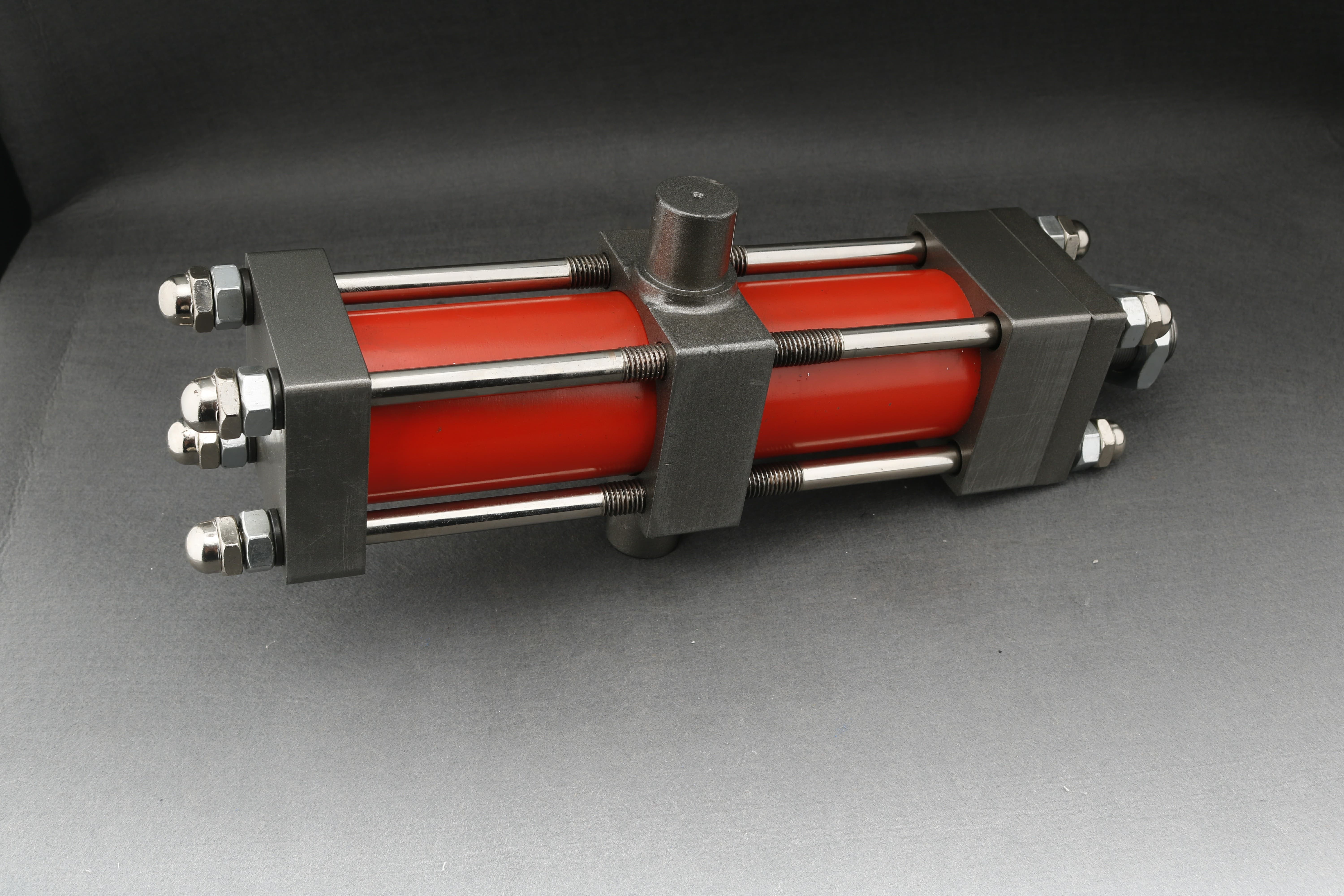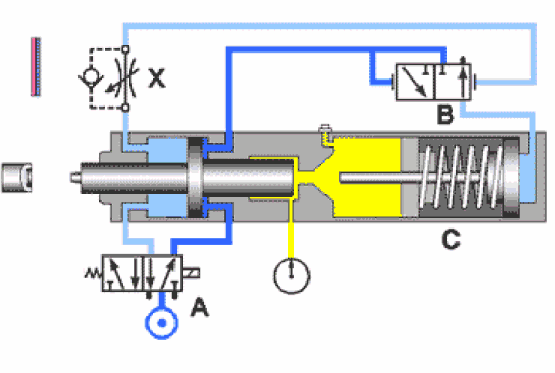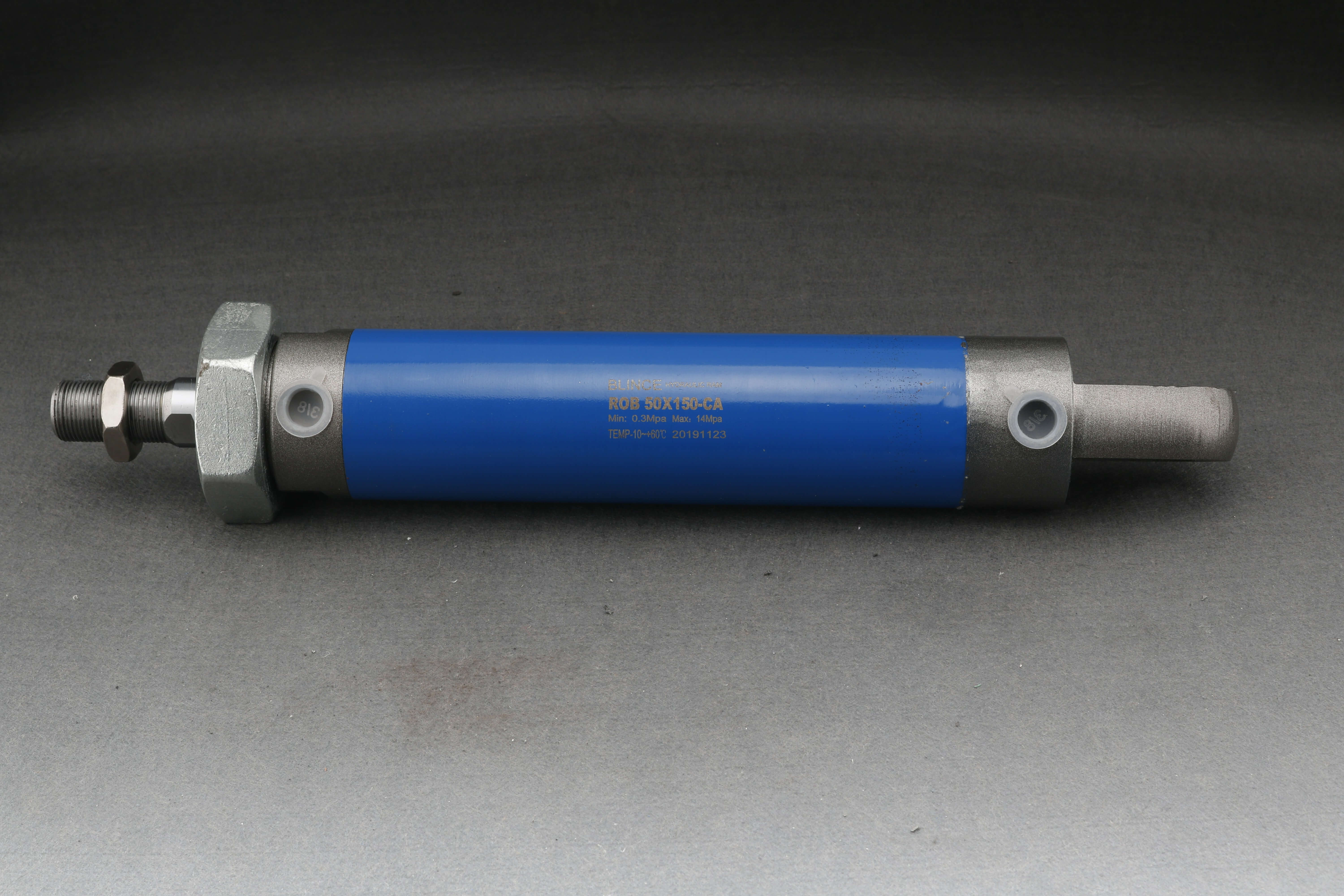A hydraulic cylinder is a hydraulic actuator that converts hydraulic energy into mechanical energy, typically to perform linear reciprocating (or oscillating) motion. Featuring a simple structure and reliable operation, hydraulic cylinders are widely used in various hydraulic systems across machinery industries. When used for reciprocating motion, they eliminate the need for a reduction gearbox, avoid transmission backlash, and ensure smooth movement.
The output force of a hydraulic cylinder is proportional to the effective piston area and the pressure differential on both sides. A standard hydraulic cylinder is primarily composed of a cylinder barrel, cylinder head, piston, piston rod, sealing elements, and optionally, cushioning and exhaust devices—depending on the application. All other components are essential.

I. Classification of Hydraulic Cylinders
Hydraulic cylinders come in various structural forms and are categorized based on different criteria:
By motion type:
Linear reciprocating hydraulic cylinders
Rotary oscillating hydraulic cylinders
By hydraulic pressure effect:
By structure:
Piston type hydraulic cylinders
Plunger type hydraulic cylinders
Telescopic (multi-stage) type hydraulic cylinders
Rack-and-pinion type hydraulic cylinders
By mounting style:
Tie-rod mount
Clevis mount
Foot mount
Trunnion mount
By pressure rating:
1. Piston-Type Hydraulic Cylinder
A single-rod piston cylinder hydraulic has a piston rod only on one end. As shown in the diagram, both ports A and B can be connected to pressure oil or return oil to enable bidirectional movement, which defines it as a double-acting cylinder.
Piston movement in one direction is powered by hydraulic pressure, while return motion may require external force. However, piston-type cylinders generally allow longer strokes than other types. Structurally, they can be single-rod or double-rod. Based on pressure application, they can be single-acting or double-acting:
Single-acting cylinder: Pressure oil acts on one chamber only, and the return stroke depends on external force (e.g., spring, gravity, or external load).
Double-acting cylinder: Both chambers alternate with pressurized oil to power bidirectional piston motion.
In the single-rod, double-acting piston cylinder, only one side of the piston is equipped with a piston rod. This results in unequal effective areas in the two chambers. Therefore:
With equal oil flow supplied, the piston speeds differ in each direction.
For the same load force, the required pressure varies depending on the chamber in use.
This asymmetry must be accounted for in hydraulic system design, such as in sanitation vehicles.
2. Plunger-Type Hydraulic Cylinder
The plunger hydraulic cylinder is a single-acting cylinder. It only performs motion in one direction using hydraulic pressure; return motion relies on external forces or the plunger’s own weight.
The plunger is supported by the cylinder sleeve but does not contact it directly, making the sleeve easy to machine. Hence, it’s ideal for long-stroke cylinders.
The plunger remains under continuous pressure during operation and must have high rigidity.
Due to its heavy weight, horizontal installation may cause sagging, leading to uneven wear on seals and guides. Vertical use is recommended.

3. Telescopic Hydraulic Cylinder
Telescopic hydraulic cylinders consist of two or more piston stages. During extension, pistons extend sequentially from the largest to the smallest; during retraction (under no load), the sequence is generally smallest to largest. This type of cylinder achieves long strokes while maintaining a short retracted length, making it compact in design. Commonly used in construction and agricultural machinery, telescopic cylinders have variable speed and force depending on the piston stage in motion.
4. Oscillating Hydraulic Cylinder
Oscillating hydraulic cylinders convert hydraulic energy into reciprocating rotary motion, providing torque output. Types include:
Single-vane
Double-vane
Helical oscillating
In vane types, the stator is fixed to the cylinder body while the vane is attached to the rotor. Depending on oil flow direction, the vane drives the rotor to oscillate. Helical oscillating cylinders (more commonly dual-helical today) convert linear piston movement into a combination of linear and rotational motion using two sets of helical gears.
II. Working Principle of Hydraulic Cylinders
As actuators in hydraulic transmission systems, hydraulic cylinders are energy converters, transforming hydraulic energy into mechanical energy. Unlike hydraulic motors, which deliver continuous rotary motion, hydraulic cylinders are designed for reciprocating motion.
Hydraulic cylinders are classified into three main structural types:
Hydraulic cylinders can be used independently or combined with other actuators and mechanical systems to fulfill special functions. Their simple design and reliable operation make them indispensable in machine tools and other machinery requiring efficient hydraulic actuation.

III. Why You Can Trust This Guide
Dongguan Blince Mechanical & Electrical Co., Ltd., established in 2004, is a leading provider of complete hydraulic solutions. As your one-stop hydraulic partner, we specialize in the design, manufacturing, and distribution of a wide range of hydraulic components, including:
Our mission is to provide efficient, reliable, and cost-effective hydraulic solutions for construction, agricultural, industrial, and marine applications. With years of expertise and innovation, Blince is a trusted name in the global hydraulic industry.
IV. Impact of Improper Cylinder Extension and Retraction
Construction Machinery:
In construction machinery, telescopic hydraulic cylinders are widely used. For example, in excavators, telescopic cylinders adjust the arm’s length and depth to allow operators to perform excavation tasks in complex environments. Bulldozer blades and crane booms also rely on telescopic cylinders for precise extension and retraction.
Automation Equipment:
In automation systems, telescopic hydraulic cylinders are used to adjust device height or position—especially in lift platforms and robotic arms—enabling accurate vertical motion and improving operational efficiency. For instance, lifting platforms in the logistics sector commonly rely on telescopic cylinders to adjust height flexibly during material handling.
Agricultural Machinery:
Telescopic hydraulic cylinders are often used in agricultural equipment such as harvesters and seeders to adjust the height and angle of working arms, enabling precise operations tailored to varying agricultural needs.
Construction and Specialized Equipment:
In tower cranes, construction hoists, and aerial work platforms, telescopic cylinders are essential for adjusting boom length and platform elevation. In high-altitude operations, they offer strong power and precise control.
V. Common Causes of Failure to Extend or Retract Properly
1. System Pressure Issues and Force Imbalance
Most hydraulic cylinders are double-acting, with a rod side and a rodless side. Extension occurs when oil flows into the rodless chamber and out of the rod side; retraction is the reverse. Because the rodless chamber has a larger effective area, extension is slower but generates higher force. Retraction is faster but weaker due to a smaller area.
If system pressure is insufficient—due to a low relief valve setting or pressure loss—the cylinder may not generate enough force to retract. An overly high balance valve setting can also cause retraction failure. Therefore, when a hydraulic cylinder fails to retract, pressure should be the first thing to check, including related components like the hydraulic pump and control valve.
2. Directional Control Valve Spool Sticking/Blockage
Contamination: Solid particles (e.g., metal shavings, seal debris, oxidation byproducts) can lodge between the spool and housing (clearance only a few microns), preventing full spool movement.
Oil Degradation: Aged oil forms varnish and sludge, increasing friction and sticking.
Wear: Excessive spool-body clearance from long-term use can cause leakage or sticking.
Side Load/Deformation: Misaligned piping or improper mounting can deform the valve housing and restrict spool movement.
Hydraulic Locking: Under high pressure, asymmetric forces or fluid polarization may push the spool against the housing, greatly increasing friction.
3. One-Way Throttle Valve Malfunction
Blocked Orifice: Contamination or sludge can block the throttle or adjustment needle, restricting return flow and slowing or stopping retraction.
Check Valve Stuck: Worn or dirty check valve (ball or poppet) may fail to open, completely blocking return oil.
Incorrect Adjustment: Throttle valve inadvertently set too close to closed position.
4. Hydraulic Balance Valve Failure
Stuck Spool: Contaminants may cause the main or pilot spool to seize. During retraction, the pilot pressure must shift the main spool to open the return path. A stuck spool prevents this.
Spring Failure: Fatigue, breakage, or improper preload affects valve opening pressure. If too high, system pressure may not suffice to open the valve, causing retraction delay or instability.
Blocked Orifice: Small damping orifices regulate spool movement. Clogging may cause erratic or delayed response.
Excessive Internal Leakage: Worn spool-body clearance causes slow pilot pressure buildup, delaying main valve actuation.
5. Hydraulic Lock (Pilot-Operated Check Valve) Failure
Stuck Poppet: Contamination or wear can cause the check valve to stick closed, blocking the return flow from the rodless chamber.
Pilot Piston Seizing/Leakage: Sticking or internal leakage in the pilot piston prevents sufficient pilot pressure buildup to release the check valve.
Spring Failure: A broken or fatigued return spring may cause the valve to remain stuck open (causing internal leakage) or fail to open when needed.
6. Increased Internal Leakage in Valves
Wear: Enlarged clearances reduce control and pressure buildup.
Seal Damage: Worn or damaged dynamic (e.g., T-seals) or static seals cause bypass flow.
Scratching: Hard contaminants can scratch spool surfaces.
Leakage reduces effective flow and delays pressure buildup, affecting retract force and timing. It also decreases system efficiency and increases oil temperature.

7. Bent or Deformed Piston Rod
Causes: Misalignment, side loads, shock impact, or material defects can bend the rod.
Effects: A bent rod increases friction, especially near the guide sleeve, and may seize completely. It accelerates seal wear and causes internal or external leakage.
8. Increased Internal Leakage in Cylinder
Piston Seal Failure: Aging, wear, extrusion, tearing, improper installation, or contamination damage seals.
Cylinder Tube Damage: Scratches or wear due to contamination, rod bending, or poor installation compromise the seal surface.
Piston Wear/Looseness: A loose piston or worn threads can create axial movement or excessive clearance, allowing high-pressure oil from the rodless chamber to leak into the rod side, reducing effective pressure and retraction force.
9. Inadequate System Pressure/Flow
Pump Wear/Failure: Reduced volumetric efficiency due to internal leakage or drive issues.
Relief Valve Setting Issues: Incorrect pressure setting or unintentional opening during retraction due to spool sticking, spring failure, or orifice blockage.
Poor Suction: Blocked suction filter, low reservoir level, air leaks, or undersized suction line can cause cavitation and reduced output.
Other Actuators in Use: In multi-actuator systems, other components may consume flow and pressure.
10. Hydraulic Fluid Issues
Contamination: The root cause of most valve sticking, seal wear, and clogging issues. Exceeding ISO 4406 contamination limits is common.
Viscosity Mismatch:
Too High (cold starts or incorrect fluid): Increases resistance, delays valve movement, and reduces pump suction.
Too Low (overheating or degraded fluid): Increases internal leakage and wear.
Oil Degradation: Oxidation, hydrolysis, and additive depletion lead to sludge, high acidity, corrosion, clogged filters, and accelerated seal failure.
Air Entrainment/Foaming: Air leaks or poor tank design reduce stiffness and cause delays, instability, and noise, potentially leading to cavitation damage.
11. Piping and Connection Problems
Crushed/Bent Lines: Restrict oil flow, increasing back pressure or reducing supply.
Undersized Lines: High flow velocity increases pressure loss.
Leakage: External leaks reduce pressure; internal leaks at joints (e.g., damaged O-rings) cause flow loss.
Accumulator Malfunction: If retraction relies on an accumulator, a failed bladder, low pre-charge pressure, or faulty valve reduces available flow.
12. Cavitation
Cause: High return line resistance (e.g., clogged filter, closed throttle valve) or insufficient pump flow may create vacuum in the rod chamber, causing oil to vaporize.
Effect: Bubble collapse produces pressure shocks, causing pitting, vibration, noise, and erratic motion. Over time, it damages cylinder walls and pistons, worsening internal leakage.


























